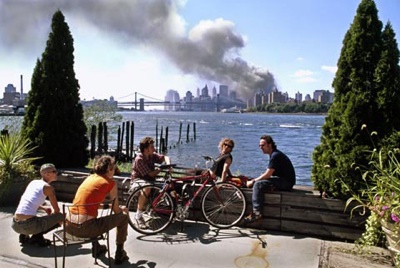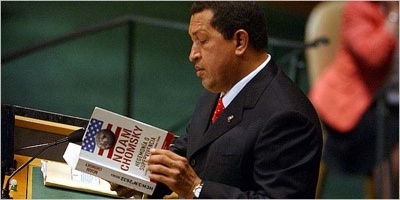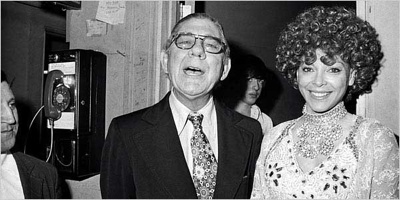Notes
Reading Vs. Reading In
There is a world of difference between “reading” and “reading into” a photo.
After almost two years of daily practice, I, along with readers of this site, have acquired a much greater intelligence and care over how to go about it. In less thoughtful hands, however, the practice can be imprecise at best, and wildly misleading at worst.
If this photo reminds you of the “Pregnant Pause” photo and discussion on The BAG back on August 23rd, you’re not off base. This shot, taken by Thomas Hoepker, is another from David Friend’s book, Watching the World Change: The Stories Behind the Images of 9/11. This shot however, became the source of a media controversy over how to look at it, and what it actually depicts.
In marking the five year anniversary of the 9/11 attacks, Frank Rich used part of his visually-minded column on September 10th (here, via RadicalLeft) to take on this photo set on the Brooklyn waterfront. He writes:
Seen from the perspective of 9/11’s fifth anniversary, Mr. Hoepker’s photo is prescient as well as important—a snapshot of history soon to come. What he caught was this: Traumatic as the attack on America was, 9/11 would recede quickly for many. This is a country that likes to move on, and fast. The young people in Mr. Hoepker’s photo aren’t necessarily callous. They’re just American. In the five years since the attacks, the ability of Americans to dust themselves off and keep going explains both what’s gone right and what’s gone wrong on our path to the divided and dispirited state the nation finds itself in today.
In his ready interpretation of the image, Rich’s reads something close to callousness into the subjects. His belief is that, in the presence of this horrific event, these people, in supposedly typical American fashion, have already “moved on.”
Most of the time at The BAG, we look at political images (more often, news photos) in terms of the role a particular image plays in a larger political narrative or propaganda agenda. At other times, we are considering the picture in terms of a publication’s marketing or editorial agenda. Supported by my training in character psychology, we do also look at photos as “data” in attempting to understand both individual and group personality and behavior.
What is important to emphasize, however, is that, in the later focus, it is profoundly speculative to offer opinions, or ascribe motives and intentions, to photographic subjects who are unknown to us. Further, it is completely unprofessional (even for a professional) to state these “projections” as “fact,” as opposed to hypothesis.
Why I belabor the point, and why I’m so excited about this post, is because Thomas Hoepker and Slate provide us us the rarest of opportunities here. There have been few cases at The BAG where we have been able to hear directly from the subject of a political photo. In this wonderful instance (if I dare use “wonderful” in regards to anything having to do with 9/11), we not only have access to the thoughts and reflections of the photographer upon capturing the image, but we actually have direct, first-person accounts of two of those supposedly “movin’ on Americans” in question.
As I understand it, both Walter Sipser, a Brooklyn artist at the far right of the picture, and then Chris Schiavo, the woman second from the right, spontaneously emailed Slate after having heard about this on-line debate. Given the importance to what we do here at The BAG, I have reproduced both of these accounts in full. (I should also mention, Slate says it verified that each person was who they said they were.)
Walter Sipser writes:
A snapshot can make mourners attending a funeral look like they’re having a party.
Thomas Hoepker took a photograph of my girlfriend and me sitting and talking with strangers against the backdrop of the smoking ruin of the World Trade Center on September 11th. Earlier, she and I had watched the buildings collapse from my rooftop in Brooklyn and had made our way down to the waterfront. The Williamsburg Bridge was filled with hundreds of people, covered in dust, helping one another make their way onto the street. It was clear that people who ordinarily would not have spoken two words to each other were suddenly bound together, which I suppose must be a fairly common occurrence in the aftermath of a catastrophe.
We were in a profound state of shock and disbelief, like everyone else we encountered that day. Thomas Hoepker did not ask permission to photograph us nor did he make any attempt to ascertain our state of mind before concluding five years later that, “It’s possible they lost people and cared, but they were not stirred by it.”
Had Hoepker walked fifty feet over to introduce himself he would have discovered a bunch of New Yorkers in the middle of an animated discussion about what had just happened. He instead chose to publish the photograph that allowed him to draw the conclusions he wished to draw, conclusions that also led Frank Rich to write, “The young people in Mr. Hoepker’s photo aren’t necessarily callous. They’re just American.” A more honest conclusion might start by acknowledging just how easily a photograph can be manipulated, especially in the advancement of one’s own biases or in the service of one’s own career.
Still, it was nice being described as a young person. I was forty at the time the photograph was taken.
And here is the poignant e-mail Chris Schiavo sent to Slate. According to the website, she was Sipser’s girlfriend at the time. Her message was titled: “From the contortionist sunbather.” She writes:
I am one of the “disaffected sunbathing youth” in the photo. I think Walter Sipser and your readers have already voiced most of what should be considered when looking at this photo in conjunction with the New York Times article.
I am also a professional photographer and did not touch a camera that day. Why? For many reasons including a now-obvious one: This somewhat cynical expression of an assumed reality printed in the New York Times proves a good reason. (Shame on Mr. Rich and Mr. Hoepker—one should never assume.) But most of all to keep both hands free, just in case there was actually something I could do to alter this day or affect a life, to experience every nanosecond in every molecule of my body, rather than place a lens between myself and the moment. (Sounds pretty “callous,” huh?) I also have a strict policy of never taking a photograph of a person without their permission or knowledge of my intent.
I am a third-generation native New Yorker, who knows and loves every square inch of this city, as did her ancestors before her. My mother and father are both architects and artists who have contributed much to the landscape of this city and my knowledge of the buildings that are my hometown and my childhood friends. (Ironically, my mother even worked for Minoru Yamasaki, the World Trade Center architect.) The point being, it was genetically impossible for me to be unaffected by this event.
Finally, just to “keep us honest,” I thought I would link to this David Friend post, offering a photo that was sent to him after compiling the images for his book. I like it because it demonstrates, even after having read these accounts, how a similar image — available just to the eye, without additional context, and even after this discussion — could still cause consternation.
(image: Thomas Hoepker. New York. September 11, 2001. Via slate.com)



Reactions
Comments Powered by Disqus